
The Winter Months
ATTACK TO THE
RHINE
| Planning for an attack eastward to the Rhine to
smash and clear the enemy salient south of Drusenheim began on January 26. By the time the
first phase of the broad general attack jumped off, a sudden thaw, melting the foot-deep
blanket of snow, had intervened, jeopardizing the fulfill. ment of a swift
armor-infantry-team assault. On the
night of January 31, the 2nd Battalion, 142nd Infantry, moved out across the Moder River
with the mission of seizing Oberhoffen, a small town upstream from Bischwiller. Stealthily
flanking the triangular-shaped village on the open ground to the east, the battalion
worked into town and seized first objectives with easy success. But at dawn, before
armor-carrying bridges over the Moder could be completed, German tanks and infantry lashed
back in wild fury and threw out the 2nd Battalion infantry. By noon our forces had lost
all objectives in Oberhoffen except a small foothold in the southern extremity. With
bridges in, the fight for Oberhoffen had to begin all over again.
TIGER TANKS
Armor was brought across the river and thrown into
the second assault but the situation changed very little. By late afternoon the 1st
Battalion moved up to pass through the 2nd. While Company A attacked frontally a German
strongpoint at the main road fork, Company C skirted the town from the south after dark
and delivered a stunning blow to the rear. The pincers snapped the resistance before
Company A, and soon both companies had consolidated a new line 300 yards above the fork.
For another forty-eight hours the 1st Battalion continued a slow, methodical advance
clearing Oberhoffen house by house, and driving off the enemy’s mammoth Royal Tiger
tanks sent in to stop it. On February 3, with all the northwest corner of Oberhoffen won,
the 1st Battalion turned over the sector to an armored infantry battalion for a three-day
interval.
|
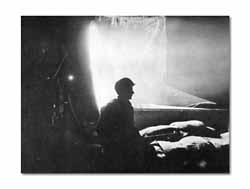
| A combat innovation introduced by the 36th in the Seventh Army
sector, anti-aircraft searchlights, emplaced several thousand yards to the rear, cast
synthetic moonlight over the immediate front and aided doughboys on defense by showing up
any moving object. The lights could be turned on or off as the situation warranted. |
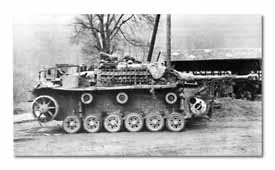
| After snows melted, scores of KO'd tanks dotted Herrlisheim
battlefield. |
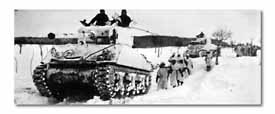
| Division infantry units in reserve tested the effectiveness of
camouflage capes and whitewashed tanks. |
|
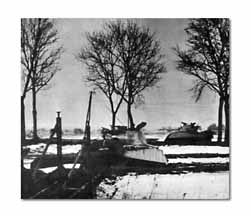
| Whitewashed to blend with the snow, our tanks crossed the
treadway bridge over the Moder. |
|
Failure to win Oberhoffen in twenty-four hours and
the appearance of strong German forces there cost a one-day delay in the Division
attack for Rohrwiller and Herrlisheim. The decision to proceed after dark of February 2 on
this second phase was taken as the extreme thaw entered its fourth day. By jump-off time,
the flat ground, criss-crossed by numerous streams and canals, had turned to swelling
pools of water. The Moder River overflowed its banks, and its icy torrents washed away all
the footbridges at Bischwiller. It covered the treadway bridge where foot soldiers crossed
and waded through 300 yards of flooded ground to reach nearby assembly positions. |
FOUR
BATTALIONS IN ATTACK
Four battalions figured in the sweeping Division
attack: on the left, the 3rd Battalion, 142nd, moved out to seize the Drusenheim woods; in
the center, the 1st Battalion, 143rd, had Rohrwiller as its objective; the 2nd Battalion,
143rd, on the right of the 1st after cutting the important Drusenheim-Herrlisheim road
link at the junction east of Rohrwiller, would then turn south to hit Herrlisheim from the
north; on the Division right the 3rd Battalion, 141st, had the difficult mission of taking
Herrlisheim on a barren approach from the south.
| Infantrymen of the 143rd plowed through knee-deep
mud and water, stumbled over many a quick-running ditch to close in on Rohrwiller. Happily
a flight of friendly bombers roared overhead to drown out the noise of approaching troops.
When the 1st Battalion broke into town it was evident that the enemy had been caught
napping. Radios were still playing, field phones connected. In one house were
freshly-dressed ducks and a newlyslaughtered pig. Before daylight 120 prisoners had been
rounded up in the town. Tanks and
weasel tractors, following the infantry and bringing up bridging materials, early bogged
down in the mire. By hand, men dragged the heavy bridge parts crosscountry to the sites
where they were to be used. Southeast of Rohrwiller two vital bridges were seized intact
by the alert 2nd Battalion, which pushed on to gain its objective at the road junction by
dawn, February 3.
The 3rd Battalion, 142nd, walked to within 100
yards of the dark line that marked the edge of Drusenheim woods, when five enemy machine
gunners broke the silence. A whooping I Company Indian-style assault chased the enemy
gunners. But the Germans, after being aroused, concentrated five tanks for an attack that
sent K Company streaming back across the Moder. By morning, however, elements of the 3rd
Battalion were holding water-filled foxholes on their objective, the south portion of the
woods.
|
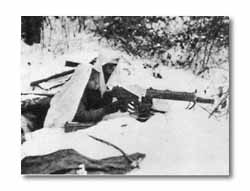
| In a combat position near Weyersheim the bed sheet blended well
with the snow. In one week while on defense snow piled to one-foot depth. |
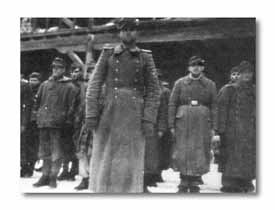
| Lanky, SS Lieutenant Helmut Kunte, was the 20,000th prisoner
taken by the Division after the Southern France landings. He was captured by the 143rd. |
|
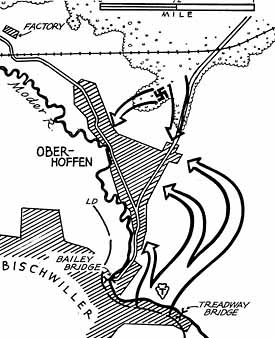
| Failure to get supporting armor over river obstacles early,
thwarted opening attacks on Oberhoffen (above) and Herrlisheim (below).
Both towns were eventually taken. |
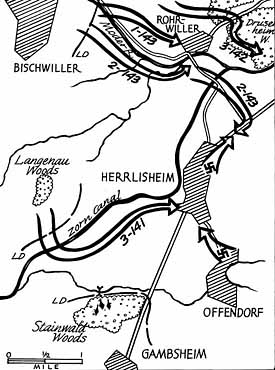
|
Companies I and K led the attack of the 141st for
Herrlisheim. Both had to cross a canal by footbridge, then make a two-kilometer approach
on open terrain to the objective. Enemy-held Offendorf closely flanked the attacking
parties on the east. The troops, crossing the line of departure at 0300, were beset by
similar mud-and-water lagoons sorely affecting the advance. When within 400 yards of
Herrlisheim, German weapons sounded the alarm. Soon a heavy fire fight flared up until, at
daylight, some 175 of the Battalion broke for the shelter of the town buildings. A great
deal of confusion occurred after reaching the buildings when regular fighting teams were
split and reorganization could not be effected. The Germans had strong points in eight
houses on the edge of town. Though attacking troops took up firing positions within
buildings and in foxholes around eight other houses, many of the men woefully learned that
their mud-caked weapons were of little use, hopefully waited for reinforcement and for
tanks which could blast the enemy opposition. The tanks never appeared, as flood
conditions which caused the canal to rise four and one-half feet in six hours delayed
completion of a necessary bridge. Two German tanks came up the road from Offendorf and
were able to drive out a platoon of Company I after 45 minutes exchange of fire. Finally
Company I and K commanders ordered withdrawal from Herrlisheim. Spurred on by this result, the Germans rallied north of
Herrlisheim and drove the 2nd Battalion, 143rd off its objective, the road junction.
Rohrwiller came under shellfire but was firmly held. Further Division attacks during the
day cleared the Drusenheim woods.
|
Two days later the result of this
difficult four-battalion attack was more fully realized when the Germans, faced with
encirclement on the north, abandoned Herrlisheim and Offendorf. On February 6, after these
towns were occupied, patrols of the 141st were posted along the Rhine.
On January 10 the 2nd and 3rd Battalions, 143rd,
from the new line at the forward edge of the Drusenheim woods, attacked to seize
Drusenheim. Elements of Company E and Company K got into town past anti-personnel mines,
machine-guns and barbed wire entanglements. A strong road block south of town on the right
held up Company G. By late afternoon, however, when the cost of the effort became bitterly
high, troops were ordered to return to their former positions.
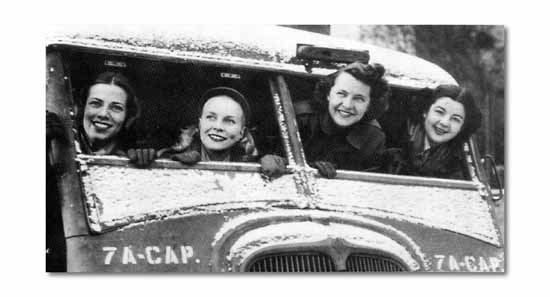
| HOLDING THE LINE, TOO, were
the 36th's smiling, doughnut serving Red Cross girls. Left to right: Dorothy
Boschen, Virginia Spetz, Jane
Cook, Meredyth Gardiner. A captured German vehicle
became their supply truck. |
|









